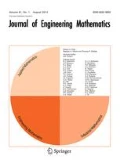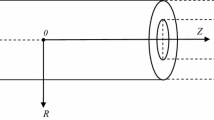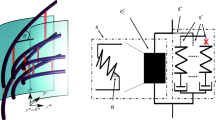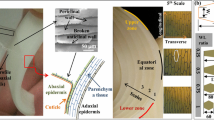Abstract
A finite strain fibre-reinforced viscoelasto-viscoplastic model implemented in a finite element (FE) analysis is presented to study the expansive growth of plant cell walls. Three components of the deformation of growing cell wall, i.e. elasticity, viscoelasticity and viscoplasticity-like growth, are modelled within a consistent framework aiming to present an integrative growth model. The two aspects of growth—turgor-driven creep and new material deposition—and the interplay between them are considered by presenting a yield function, flow rule and hardening law. A fibre-reinforcement formulation is used to account for the role of cellulose microfibrils in the anisotropic growth. Mechanisms in in vivo growth are taken into account to represent the corresponding biology-controlled behaviour of a cell wall. A viscoelastic formulation is proposed to capture the viscoelastic response in the cell wall. The proposed constitutive model provides a unique framework for modelling both the in vivo growth of cell wall dominated by viscoplasticity-like behaviour and in vitro deformation dominated by elastic or viscoelastic responses. A numerical scheme is devised, and FE case studies are reported and compared with experimental data.











Similar content being viewed by others
References
Refregier G, Pelletier S, Jaillard D, Hofte H (2004) Interaction between wall deposition and cell elongation in dark-grown hypocotyl cells in Arabidopsis. Plant Physiol 135:959–968
Cosgrove DJ (2001) Wall structure and wall loosening. A look backwards and forwards. Plant Physiol 125:131–134
McCann MC, Wells B, Roberts K (1990) Direct visualization of cross-links in the primary plant cell wall. J Cell Sci 96:323–334
Iwamoto S, Kai W, Isogai A, Iwata T (2009) Elastic modulus of single cellulose microfibrils from tunicate measured by atomic force microscopy. Biomacromolecules 10:2571–2576
Marga F, Grandbois M, Cosgrove DJ, Baskin TI (2005) Cell wall extension results in the coordinate separation of parallel microfibrils: evidence from scanning electron microscopy and atomic force microscopy. Plant J 43:181–190
Suslov D, Verbelen J-P (2006) Cellulose orientation determines mechanical anisotropy in onion epidermis cell walls. J Exp Bot 57:2183–2192
Dumais J, Shaw SL, Steele CR, Long SR, Ray PM (2006) An anisotropic-viscoplastic model of plant cell morphogenesis by tip growth. Int J Dev Biol 50:209–222
Cosgrove DJ (1993) Wall extensibility: its nature, measurement and relationship to plant cell growth. New Phytol 124:1–23
Schopfer P (2006) Biomechanics of plant growth. Am J Bot 93:1415–1425
Cosgrove DJ (1998) Cell wall loosening by expansins. Plant Physiol 118:333–339
Cosgrove DJ (2000) Loosening of plant cell walls by expansins. Nature 407:321–326
Cosgrove DJ (2005) Growth of the plant cell wall. Nat Rev Mol Cell Biol 6(11):850–861
Choi D, Cho H, Lee Y (2006) Expansins: expanding importance in plant growth and development. Physiol Plant 126:511–518
Taiz L (1984) Plant cell expansion: regulation of cell wall mechanical properties. Annu Rev Plant Physiol 35:585–657
Kutschera U (1990) Cell-wall synthesis and elongation growth in hypocotyls of Helianthus annuus. Planta 181:316–323
Proseus TE, Boyer JS (2006) Identifying cytoplasmic input to the cell wall of growing Chara corallina. J Exp Bot 57:3231–3242
Rojas ER, Hotton S, Dumais J (2011) Chemically mediated mechanical expansion of the pollen tube cell wall. Biophys J 101:1844–1853
Fung YC (1993) Biomechanics: mechanical properties of living tissues. Springer, New York
Hohl M, Schopfer P (1992) Physical extensibility of maize coleoptile cell walls: apparent plastic extensibility is due to elastic hysteresis. Planta 187:498–504
Keckes J, Burgert I, Frühmann K, Müller M, Kölln K, Hamilton M, Burghammer M, Roth SV, Stanzl-Tschegg SE, Fratzl P (2003) Cell-wall recovery after irreversible deformation of wood. Nat Mater 2:810–814
Lockhart JA (1965) An analysis of irreversible plant cell elongation. J Theor Biol 8:264–275
Lockhart JA (1965) Cell extension. In: Bonner J, Varner JE (eds) Plant biochemistry. Academic Press, New York, pp 827–849
Verbelen J-P, Vissenberg K (2007) Cell expansion: past, present and perspectives. In: Verbelen J-P, Vissenberg K (eds) The expanding cell. Springer, Berlin, pp 1–6
Green PB, Erickson RO, Buggy J (1971) Metabolic and physical control of cell elongation rate. In vivo studies in Nitella. Plant Physiol 47:423–430
Ray PM, Green PB, Cleland R (1972) Role of turgor in plant cell growth. Nature 239:163–164
Ortega JKE (1990) Governing equations for plant cell growth. Physiol Plant 79:116–121
Cosgrove DJ (1986) Biophysical control of plant cell growth. Annu Rev Plant Physiol 37:377–405
Geitmann A, Ortega JKE (2009) Mechanics and modelling of plant cell growth. Trends Plant Sci 14:467–478
Pietruszka M (2009) General proof of the validity of a new tensor equation of plant growth. J Theor Biol 256:584–585
Veytsman BA, Cosgrove DJ (1998) A model of cell wall expansion based on thermodynamics of polymer networks. Biophys J 75:2240–2250
Boudaoud A (2003) Growth of walled cells: from shells to vesicles. Phys Rev Lett 91:018104
Bruce DM (2003) Mathematical modelling of the cellular mechanics of plants. Philos Trans R Soc Lond B 358:1437–1444
Kerstens S, Decraemer WF, Verbelen J-P (2001) Cell walls at the plant surface behave mechanically like fiber-reinforced composite materials. Plant Physiol 127:381–385
Hettiaratchi DRP, O’Callaghan JR (1978) Structural mechanics of plant cells. J Theor Biol 74:235–257
Chaplain MAJ (1993) The strain energy function of an ideal plant cell wall. J Theor Biol 163:77–97
Dyson RJ, Jensen OE (2010) A fibre-reinforced fluid model of anisotropic plant cell growth. J Fluid Mech 655:472–503
Dyson RJ, Band LR, Jensen OE (2012) A model of crosslink kinetics in the expanding plant cell wall: yield stress and enzyme action. J Theor Biol 307:125–136
Geitmann A (2010) Mechanical modeling and structural analysis of the primary plant cell wall. Curr Opin Plant Biol 13:693–699
Geitmann A (2011) Generating a cellular protuberance: mechanics of tip growth. In: Wojtaszek P (ed) Mechanical integration of plant cells and plants. Springer, Berlin, pp 117–132
Kha H, Tuble SC, Kalyanasundaram S, Williamson RE (2010) WallGen, software to construct layered cellulose-hemicellulose networks and predict their small deformation mechanics. Plant Physiol 152:774–786
Goriely A, Tabor M (2003) Biomechanical models of hyphal growth in actinomycetes. J Theor Biol 222:211–218
Bernal R, Rojas ER, Dumais J (2007) The mechanics of tip growth morphogenesis: what we have learned from rubber balloons. J Mech Mater Struct 2:1157–1168
Hamant O, Heisler MG, Jönsson H, Krupinski P, Uyttewaal M, Bokov P, Corson F, Sahlin P, Boudaoud A, Meyerowitz EM, Couder Y, Traas J (2008) Developmental patterning by mechanical signals in Arabidopsis. Science 322:1650–1655
Kierzkowski D, Nakayama N, Routier-Kierzkowska A-L, Weber A, Bayer E, Schorderet M, Reinhardt D, Kuhlemeier C, Smith RS (2012) Elastic domains regulate growth and organogenesis in the plant shoot apical meristem. Science 335:1096–1099
Baskin TI (2005) Anisotropic expansion of the plant cell wall. Annu Rev Cell Dev Biol 21:203–222
Epstein M, Maugin GA (2000) Thermomechanics of volumetric growth in uniform bodies. Int J Plast 16:951–978
Kuhl E, Steinmann P (2003) Mass- and volume-specific views on thermodynamics for open systems. Proc R Soc Lond A 459:2547–2568
Guillou A, Ogden RW (2006) Growth in soft biological tissue and residual stress development. In: Holzapfel GA, Ogden RW (eds) Mechanics of biological tissue. Springer, Berlin, pp 47–62
Garikipati K, Arruda EM, Grosh K, Narayanan H, Calve S (2004) A continuum treatment of growth in biological tissue the coupling of mass transport and mechanics. J Mech Phys Solids 52:1595–1625
Humphrey JD, Rajagopal KR (2002) A constrained mixture model for growth and remodeling of soft tissues. Math Models Methods Appl Sci 12:407–430
Huang R, Becker AA, Jones IA (2012) Modelling cell wall growth using a fibre-reinforced hyperelastic–viscoplastic constitutive law. J Mech Phys Solids 60:750–783
Simo JC, Hughes TJR (1998) Computational inelasticity. Springer, New York
Moran B, Ortiz M, Shih CF (1990) Formulation of implicit finite element methods for multiplicative finite deformation plasticity. Int J Numer Methods Eng 29:483–514
Belytschko T, Liu WK, Moran B (2001) Nonlinear finite elements for continua and structures. Wiley, Chichester
Marsden JE, Hughes TJR (1994) Mathematical foundation of elasticity. Dover, NewYork
Gasser TC, Ogden RW, Holzapfel GA (2006) Hyperelastic modelling of arterial layers with distributed collagen fibre orientations. J R Soc Interface 3:15–35
Skalak R (1981) Growth as a finite displacement field. In: Carlson DE, Shield RT (eds) Proceedings off the IUTAM symposium on finite elasticity. Martinus Nijhoff Publishers, The Hague, pp 347–355
Chuong CJ, Fung YC (1986) Residual stress in arteries. In: Schmid-Schonbein GW, Woo SL-Y, Zweifach BW (eds) Frontiers in biomechanics. Springer, New York, pp 117–129
Chuong CJ, Fung YC (1986) On residual stresses in arteries. J Biomech Eng 108:189–192
Fung YC (1990) Biomechanics: motion, flow, stress, and growth. Springer, New York
Rodriguez EK, Hoger A, McCulloch A (1994) Stress-dependent finite growth in soft elastic tissue. J Biomech 27:455–467
Lee EH (1969) Elastic-plastic deformation at finite strain. J Appl Mech ASME 36:1–6
Gasser TC, Forsell C (2011) The numerical implementation of invariant-based viscoelastic formulations at finite strains. An anisotropic model for the passive myocardium. Comput Methods Appl Mech Eng 200:3637–3645
Humphrey JD, Rajagopal KR (2003) A constrained mixture model for arterial adaptations to a sustained step change in blood flow. Biomech Model Mechanobiol 2:109–126
Maugin GA (1999) The thermomechanics of nonlinear irreversible behaviours. World Scientific, Singapore
Proseus TE, Ortega JKE, Boyer JS (1999) Separating growth from elastic deformation during cell enlargement. Plant Physiol 119:775–784
Reese S, Govindjee S (1998) A theory of finite viscoelasticity and numerical aspects. Int J Solids Struct 35:3455–3482
Spencer AJM (2001) A theory of viscoplasticity for fabric-reinforced composites. J Mech Phys Solids 49:2667–2687
Proseus TE, Zhu G-L, Boyer JS (2000) Turgor, temperature and the growth of plant cells using Chara corallina as a model system. J Exp Bot 51:1481–1494
Thomas A, Tomos AD, Stoddart JL, Thomas H, Pollock CJ (1989) Cell expansion rate, temperature and turgor pressure in growing leaves of Lolium temulentum L. New Phytol 112:1–5
Mandel J (1971) Plasticité Classique et Viscoplasticité (CISM Lecture Notes, Udine, Italy). Springer, Vienna
Lubliner J (1990) Plasticity theory. Macmillan, New York
Maugin GA (2011) Configurational forces: thermo-mechanics, physics, mathematics and numerics. CRC Press, Boca Raton
Epstein M, Maugin GA (1996) On the geometrical structure of anelasticity. Acta Mech 115:119–131
Proseus TE, Boyer JS (2007) Tension required for pectate chemistry to control growth in Chara corallina. J Exp Bot 58:4283–4292
Niklas KJ (1992) Plant biomechanics: an engineering approach to plant form and function. University of Chicago Press, Chicago
Boyer JS (2009) Cell wall biosynthesis and the molecular mechanism of plant enlargement. Funct Plant Biol 36:383–394
Proseus TE, Boyer JS (2005) Turgor pressure moves polysaccharides into growing cell walls of Chara corallina. Ann Bot 95:967–979
Toole GA, Gunning PA, Parker ML, Smith AC, Waldron KW (2001) Fracture mechanics of the cell wall of Chara corallina. Planta 212:606–611
Milani P, Gholamirad M, Traas J, Arnéodo A, Boudaoud A, Argoul F, Hamant O (2011) In vivo analysis of local wall stiffness at the shoot apical meristem in Arabidopsis using atomic force microscopy. Plant J 67:1116–1123
Cousins WJ (1978) Young’s modulus of hemicelluloses as related to moisture content. Wood Sci Techol 12:161–167
Wang CX, Wang L, Thomas CR (2004) Modelling the mechanical properties of single suspension-cultured tomato cells. Ann Bot 93:443–453
Wei C, Lintilhac PM, Tanguay JJ (2001) An insight into cell elasticity and load-bearing ability: measurement and theory. Plant Physiol 126:1129–1138
Acknowledgments
This work was conducted in the Centre for Plant Integrative Biology, the University of Nottingham, U.K., which is jointly funded by the BBSRC/EPSRC (BB/D0196131/1) as part of their Systems Biology Initiative. The authors also gratefully acknowledge the valuable input of Prof. M. Bennett, Dr. L. Band and Dr. Zhefeng Lin to the literature survey.
Author information
Authors and Affiliations
Corresponding author
Appendices
Appendix 1: The update algorithm of \({\overline{\varvec{S}}}\) and \(\overline{\mathbb {C}}^\mathrm{v}\)
The update criterion (11) for the configuration \(\tilde{{\mathcal {B}}}_t \) is implemented as follows:

where the increments \(\Delta {\tilde{\varvec{F}}}_n \) and  are defined as follows:
are defined as follows:

in which the velocity gradient \({\varvec{L}}_n^\mathrm{ve}\) is computed from \(\Delta {\varvec{F}}_n^\mathrm{ve}\) by using the relation
The update of the algorithmic internal variables \({\tilde{\varvec{H}}}_{n+1}\) and  is obtained by using the middle rule [52] as follows:
is obtained by using the middle rule [52] as follows:

where \({\tilde{\tilde{\varvec{H}}}}_n \) and  are defined as
are defined as

In order to obtain expressions of \({\overline{\varvec{S}}}\) and \(\overline{\mathbb {C}}^\mathrm{v}\), specified functions \(W^{\circ }\) and \(\tilde{W}^{\circ }\) in Eqs. (38) and (39) are set in the similar form as the deviatoric part of the free energy of wall matrix in Eq. (31) as follows:

Thus, the stress tensors \({\tilde{\varvec{S}}{}_{n+1}^\circ }\) and  in Eqs. (105) and (106) is obtained by using Eqs. (38) and (39) as
in Eqs. (105) and (106) is obtained by using Eqs. (38) and (39) as


where the deviatoric operators are defined as
Substituting Eqs. (105), (106), (111), (112) into Eq. (45) yields

where the two functions \(\tilde{g}{}_n^*\) and  are defined, respectively, as
are defined, respectively, as

By using Eqs. (115), (24) indicates that the viscoelastic components of tangent modulus is

where two operators, \(\widetilde{\hbox {DEV}}[ { \cdot } ]\) and \({\partial \{ {{\overline{J}{}^{-2/3}}\hbox {DEV}} \}}/{\partial {\overline{\varvec{C}}}}[ { \cdot }]\), are defined, respectively, as
The remaining work is to compute two tensors  and \({\partial {\tilde{\varvec{S}}{}_{n+1}^\circ } }/{\partial {\overline{\varvec{C}}}}\) in Eq. (117).
and \({\partial {\tilde{\varvec{S}}{}_{n+1}^\circ } }/{\partial {\overline{\varvec{C}}}}\) in Eq. (117).
By using Eqs. (112) and (119),  is obtained straightforward as
is obtained straightforward as

On the other hand, by using the criterion (103) (if \(\hbox {tr}\,{\varvec{L}}^\mathrm{ve}\ge 0), {\partial {\tilde{\varvec{S}}{}_{n+1}^\circ } }/{\partial {\overline{\varvec{C}}}}\) is computed by the chain rule as follows:
where tensor \({\partial {\tilde{\varvec{S}}{}_{n+1}^\circ } }/{\partial {\tilde{\varvec{C}}}}\) is expressed as

in which by using Eq. (111) we have
The other unknown tensor in Eq. (121), \({\partial {\tilde{\varvec{C}}}}/{\partial {\overline{\varvec{C}}}}\), is deduced as follows. It can be shown that (if \(\hbox {tr}\,({\varvec{L}}^\mathrm{ve})\ge 0)\)

By using Eq. (124), two one-parameter families of right Cauchy–Green tensors are constructed in the forms of

where \(\varepsilon \) is a scalar parameter, tensor \({\varvec{H}}_n \) is defined as
The derivative of \({\tilde{\varvec{C}}}_\varepsilon \) with respect to \(\varepsilon \) is computed from Eq. (126) as

The definitions (125) and (126) indicate that
Therefore, Eqs. (128) and (129) yield the expression of \({\partial {\tilde{\varvec{C}}}}/{\partial {\overline{\varvec{C}}}}\) as follows:

Once tensors \({\partial {\tilde{\varvec{S}}{}_{n+1}^\circ } }/{\partial {\tilde{\varvec{C}}}}\) and \({\partial {\tilde{\varvec{C}}}}/{\partial {\overline{\varvec{C}}}}\) are obtained by Eqs. (122) and (130), respectively, Eq. (121) yields the expression of \({\partial {\tilde{\varvec{S}}{}_{n+1}^\circ } }/{\partial {\overline{\varvec{C}}}}\). Then the expression of \(\overline{\mathbb {C}}^\mathrm{v}\) is obtained by substituting Eqs. (118–121) into Eq. (117).
Appendix 2: The derivative of function \(\phi \)
Let \(( \cdot )\) be an entity standing for tensor, vector or scalar. By taking the derivative of Eq. (67) with respect to \(( \cdot )\) we obtain
where
in which
Using the chain rule and substituting Eq. (131) into the derivative of the distance function \(\phi \) with respect to \(\left( \cdot \right) \) yields
in which
Rights and permissions
About this article
Cite this article
Huang, R., Becker, A.A. & Jones, I.A. A finite strain fibre-reinforced viscoelasto-viscoplastic model of plant cell wall growth. J Eng Math 95, 121–154 (2015). https://doi.org/10.1007/s10665-014-9761-y
Received:
Accepted:
Published:
Issue Date:
DOI: https://doi.org/10.1007/s10665-014-9761-y
Keywords
- Biological material
- Cell wall growth
- Constitutive behaviour
- Fibre-reinforced composite material
- Finite strain
- Finite element analysis
- Viscoplastic material




